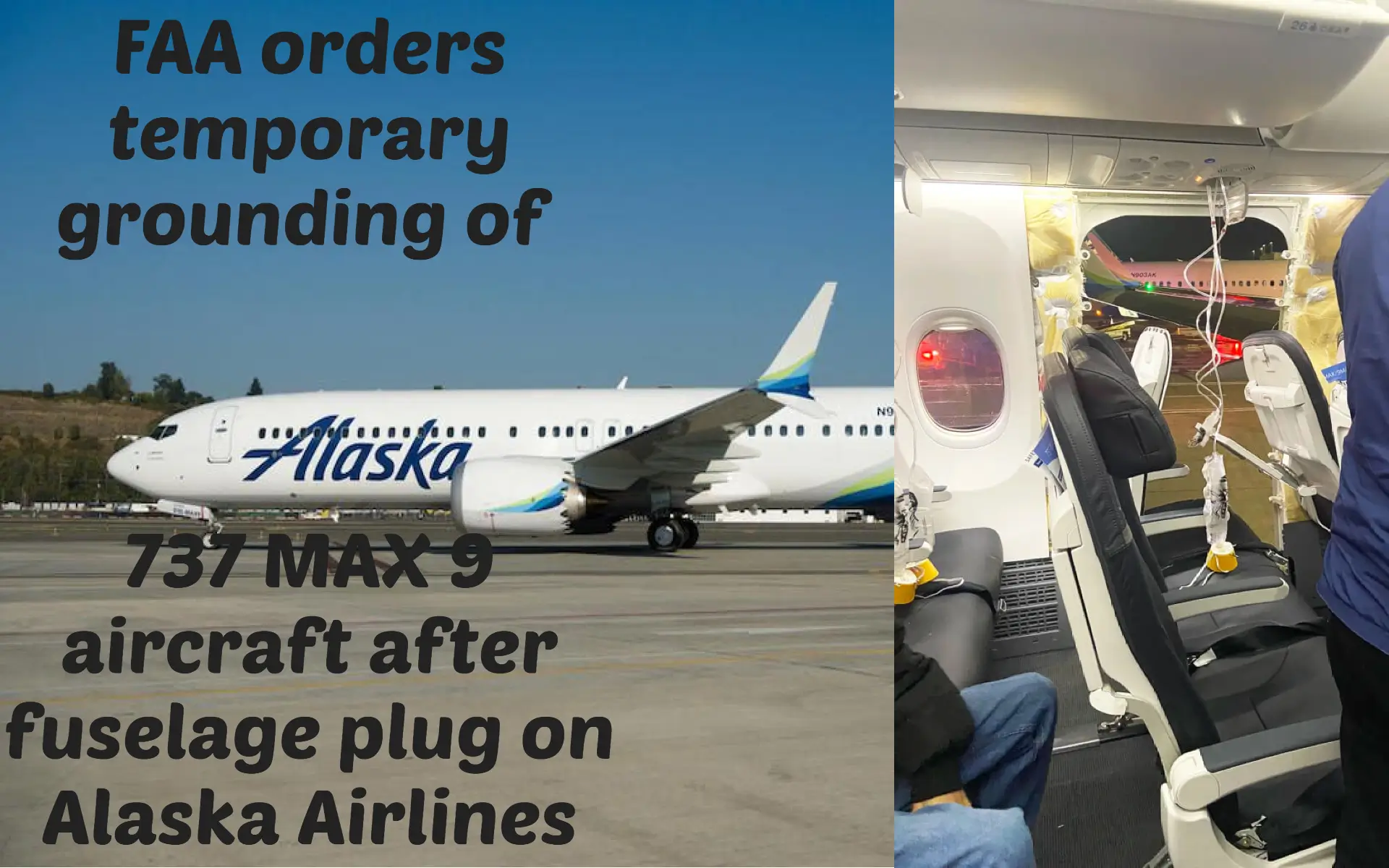
The recent incident involving an Alaska Airlines Boeing 737 Max 9 has raised concerns about the safety of these aircraft. The Federal Aviation Administration (FAA) has issued orders to ground certain 737 Max 9 planes for inspection, affecting airlines worldwide.
Alaska Airlines Flight 1282, a Boeing 737 Max 9, was en route to Ontario, California when it experienced a catastrophic blowout mid-flight. The incident resulted in a substantial section of the aircraft’s fuselage detaching, creating a gaping hole and causing a rapid decompression of the cabin. The pilot made a quick decision to return to Portland International Airport, ensuring the safety of all 174 passengers and six crew members on board.
Eyewitness accounts describe the harrowing experience of passengers as emergency oxygen masks deployed and wind rushed through the cabin. While there were no serious injuries reported, some passengers suffered minor injuries due to the sudden decompression. The incident sparked concerns about the structural integrity of the Boeing 737 Max 9 and prompted immediate action from aviation authorities.
In response to the Alaska Airlines incident, the FAA issued an emergency airworthiness directive, temporarily grounding all Boeing 737 Max 9 airplanes used by U.S. airlines and those operating within U.S. territory. This directive aims to ensure the safety of passengers and prevent any potential recurrence of similar incidents. The FAA’s decision impacts a total of 171 aircraft globally.
READ ALSO: American Airlines Passenger Accused of Punching Flight Attendant
The grounding order requires immediate inspections of the affected planes, specifically focusing on the mid-cabin door plug, which was involved in the Alaska Airlines incident. The FAA estimates that each inspection will take approximately four to eight hours per aircraft. The inspections aim to identify any potential risks or structural issues that could compromise passenger safety.
Alaska Airlines, the operator of the Boeing 737 Max 9 involved in the incident, took swift action by temporarily grounding all 65 of its Max 9 aircraft. The airline initiated maintenance and safety inspections on its entire fleet, with 18 aircraft cleared to return to service after thorough inspections. The remaining aircraft are expected to undergo inspections in the coming days.
United Airlines, which also operates the Boeing 737 Max 9, suspended service on select aircraft to conduct the required inspections. This suspension resulted in approximately 60 flight cancellations. Both Alaska Airlines and United Airlines are working closely with the FAA to comply with inspection requirements and ensure the safety of their passengers.
The National Transportation Safety Board (NTSB) has launched an investigation into the Alaska Airlines incident, with a focus on determining the root cause of the mid-cabin door plug detachment. Investigators will examine various factors, including maintenance and repair records, the pressurization system, and the aircraft’s maintenance history.
Boeing, the manufacturer of the 737 Max 9, is cooperating fully with the NTSB’s investigation. The company has expressed its support for the FAA’s grounding decision and is committed to ensuring the safety of its customers. Boeing’s technical team will provide expertise and assistance throughout the investigation process.
The Boeing 737 Max series has faced significant safety concerns in recent years. In 2018, two fatal accidents involving the 737 Max 8 led to a global grounding of these aircraft. Investigations revealed issues with the aircraft’s automated flight-control system, which erroneously activated and contributed to the crashes. Boeing implemented significant changes to the system before the FAA cleared the planes to fly again in late 2020.
READ ALSO:Alaska Airlines Flight Makes Emergency Landing in Portland Airport
Despite these remedial measures, the recent incident involving the 737 Max 9 has raised questions about the overall safety of the Max series. The aviation industry and regulatory authorities remain committed to maintaining the highest safety standards and preventing any potential risks to passengers.
Following the FAA’s directive, several international airlines have taken precautionary measures. The European Union Aviation Safety Agency (EASA) adopted the FAA’s grounding order, although no EU member state airlines currently operate the affected configuration of the Boeing 737 Max 9. Turkish Airlines and Copa Airlines have temporarily grounded their Max 9 aircraft for inspections.
Airline regulators worldwide are closely monitoring the situation. British air safety regulators stipulated that any operator of the 737 Max 9 must comply with the FAA directive before entering British airspace. Aeromexico and Icelandair have confirmed that their 737 Max 9 aircraft are not affected by the FAA grounding order.
Despite the recent incident, it is crucial to note that air travel remains one of the safest modes of transportation. The NTSB Chair, Jennifer Homendy, emphasized that the United States has the safest aviation system globally and maintains rigorous safety standards. The investigations and inspections resulting from this incident are part of the industry’s commitment to continuous improvement and maintaining the highest level of passenger safety.
The Alaska Airlines incident involving a Boeing 737 Max 9 has prompted immediate action from aviation authorities, leading to the temporary grounding of these aircraft. The FAA’s directive ensures that thorough inspections are conducted to identify any potential risks or structural issues. Airlines, including Alaska Airlines and United Airlines, are cooperating fully and prioritizing passenger safety.
Ongoing investigations by the NTSB and Boeing will shed light on the cause of the incident, allowing for further improvements in safety measures. The aviation industry remains committed to maintaining the highest safety standards, assuring passengers that air travel continues to be a reliable and secure mode of transportation.
As the investigations progress, it is essential for all stakeholders to work together to address any potential concerns and implement necessary measures to prevent future incidents. The aviation industry’s resilience and commitment to safety will ensure that passengers can continue to trust in the safety of air travel.
